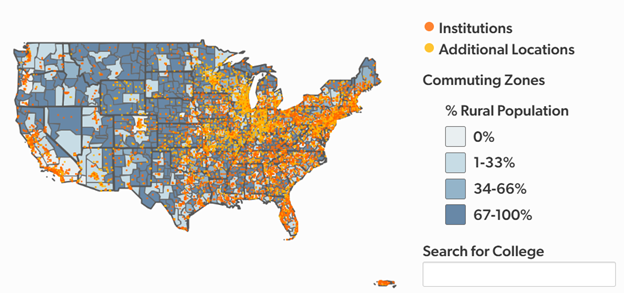By: Nicholas Hillman
You may have read recently that the SSTAR Lab is undertaking a new set of studies focused on rural students’ pathways to and through higher education. These two new studies extend our existing work on geography of opportunity.
But you may be wondering why geography/rurality is part of the Lab’s portfolio.
To answer that question, I offer my personal reflection on how I came to study rurality and where I envision the Lab going in this space.
How have I reached an orientation to rural research?
I first got interested in geography over a decade ago when studying the relationship between local unemployment rates and community college enrollment. In northern Indiana, about one in five people were unemployed during the Great Recession—economists expected people to flood back into college during this time, but that didn’t happen in this part of the state. This was largely because there are simply few public colleges nearby.
While I was working on this research, the Obama Administration was proposing a federal college rating system and researchers were publishing a lot on undermatching. Both efforts were informed by economics, where “better information” was believed to help students make “better choices” about where to go to college.
But that’s not how most students choose college. Most students (57%) attend college within just 25 miles from home.
College choice literature has always acknowledged geography plays a role in shaping whether and where students go. But that literature never quite centered geography as much as it could; and when we do center geography (around “geography of opportunity”) we can quickly see how place shapes the decision-making process and for good reasons.
And by centering geography, we can shift our mindset and understand old problems in new ways. For instance, do students make suboptimal choices (“undermatch”) because they have poor information, or is it because they are choosing the college nearest to their home? Providing better information about a college far away may not be very useful to a student who needs to stay close to home.
Similarly, by centering geography, we can quickly see some places have no/few college options nearby, and maybe this unequal opportunity structure plays a bigger role in college choices than previously considered.
Bringing geography into college choice research opens the door to new analytical techniques, visualization models, data sources, and research questions. See for example the SSTAR Lab’s Mapping Rural Colleges public and interactive data tool visualizing rural places that allows users to explore and generate new insights into rural communities and their colleges. But geography isn’t limited to college choice research—it affects so many parts of higher education, opening the door to many new areas of research (e.g., geography of ROI, geography of student loan debt, mapping rural colleges, geography of teacher labor markets, etc.).

SSTAR Lab’s Mapping Rural Colleges public and interactive data tool
I have been invited into many conversations about rural higher education because my geography work coined the phrase “education desert” and rurality is a major theme within that work. I grew up in rural places (Union, MI and Prescott Valley, AZ) so rurality speaks to me on a personal level through my lived experiences. I am still learning a lot about rural education and the scholars/scholarship in that space. And I am finding new connections to my personal background that motivate me to continue this work, so I believe carving out a slice of “rural” research from my broader “geography of opportunity” work makes good sense.
What is the Lab’s contribution to this space?
Geography cuts across many projects we are undertaking in the Lab. And I often find myself wanting to cite an existing study, resource, or easily pull data for a wide number of questions related to rurality. For example, what is the college-going rate for rural students in Wisconsin? What are their college completion rates? How many Pell-eligible students are from rural versus non-rural places, and which colleges draw the largest shares of rural students in the state? These questions have no clear answers but should.
There are many basic questions like these that simply go unanswered in Wisconsin because of data limitations. The same is true for most states. And answering them can help K-12 schools and districts, colleges and entire university systems identify strategies to support rural college access and completion. Similarly, community-based organizations, government bodies, and philanthropic organizations often want to support rural students, but do not always have baseline information about who these students are, how they navigate college choices, and where they attend college. Knowing these things can help many interested parties better support rural students.
The SSTAR Lab’s research on rural students will help answer these questions in Wisconsin and nationwide.
We will analyze and write policy briefs, reports, and academic papers on these issues over the next several years. We hope these efforts will help other academic researchers and the various stakeholders mentioned above better understand, support, and improve pathways into and through college for rural students. As our findings and data products come out, we will share them broadly here on our website and in academic and policy conferences. Ultimately, we want our work to be actionable, so administrators, practitioners, and community organizations can use our work to inform their own efforts supporting rural students. Doing so will not only help students but will provide new ways of understanding how students make college choice and the important role institutions of higher education play in their local communities.